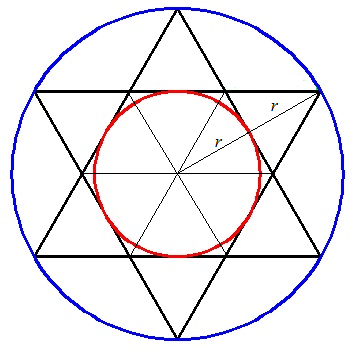Ratio of areas
As shown in the diagram to the right, extending the sides of a regular hexagon forms a six-pointed star. A red circle is inscribed in the hexagon, and a blue circle is circumscribed around the star.
What is the ratio of blue circle's area to the red circle's area?
This section requires Javascript.
You are seeing this because something didn't load right. We suggest you, (a) try
refreshing the page, (b) enabling javascript if it is disabled on your browser and,
finally, (c)
loading the
non-javascript version of this page
. We're sorry about the hassle.

r = 6 2 − 3 2 = 3 3
By symmetry, the radius of the blue circle is 2 r = 6 3 .
Finally, the ratio of the area of the blue circle to the area of the red circle, which is also the ratio of the squares of their radii is
( 3 3 ) 2 ( 6 3 ) 2 = 2 7 1 0 8 = 1 4 .